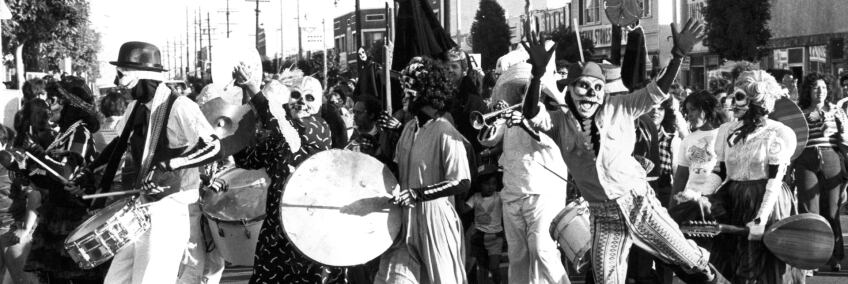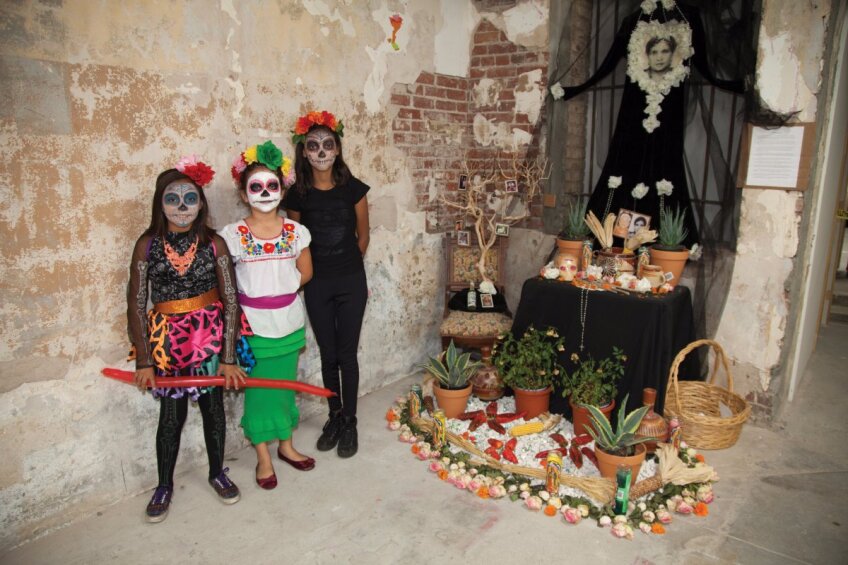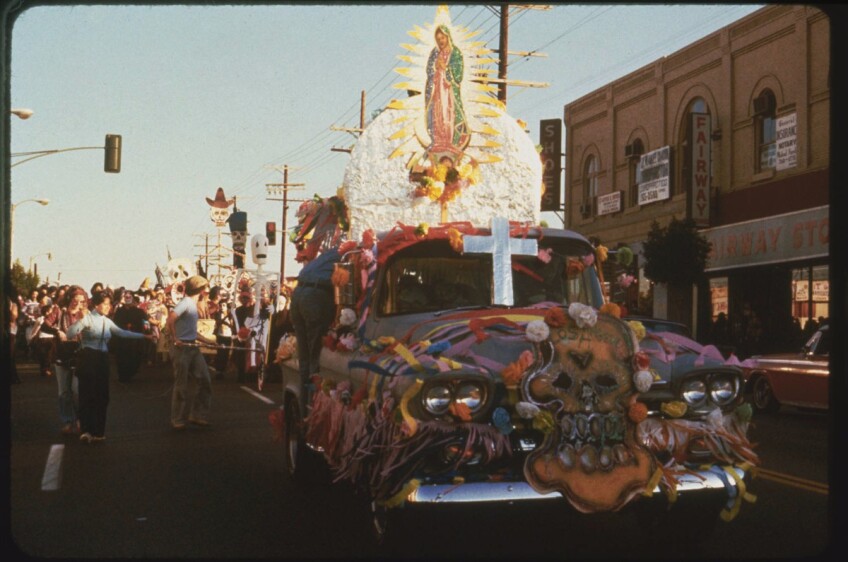Self Help Graphics and the Birth of Modern Day Día de los Muertos

This is produced in partnership with Pacific Standard Time: LA/LA, a far-reaching and ambitious exploration of Latin American and Latino art in dialogue with Los Angeles.

The current wave of Chicanx and Latin American art maybe sweeping through Southern California as part of Pacific Standard Time: LA/LA, but at Self Help Graphics & Art in Boyle Heights, it’s just another day at the office. Apart from supporting the work of artists of color, they are doing what they always do this time of year, preparing for Día de los Muertos (Day of the Dead). The legendary Chicanx-based community arts organization is playing their part in the pan-region show with “Día de los Muertos: A Cultural Legacy, Past, Present & Future,” which runs through February 24. No place could be more fitting for the show since the modern iteration of the festival began at Self Help.

“It bridges generations, especially here in Los Angeles, not only generations, but countries. Now it’s cultures, because it’s been open to the whole nation, the whole world,” Ofelia Esparza explains. A life-long resident of East L.A., she is an altarista, a master altar maker who honed her skills at Self Help in the early days. Today she is a diminutive, gray-haired figure with a gentle and dignified air, and as sharp a wit as ever.
When she was younger, she made as many as nine altars each year, but these days she’s lightened her workload. This year she intended to build three, but instead she’s doing five with the help of her daughter and son. The one at Self Help stands roughly ten feet high and twenty across, and is strewn with cempasuchil (marigold), the holiday’s traditional flower, as well as photos of Self Help co-founder Karen Boccalero with various artists and members of the community, a plate of artificial fruit, a cherub and Guadalupe icon, as well as mementos from Esparza’s own garden such as pebbles and shells.

Back in the early seventies, the annual Mexican festival rooted in pre-Colombian and Catholic tradition jumped the border aided by Self Help. The first celebration in the early seventies was held inside Self Help, a parade for children with handmade costumes. What started as a traditionally a solemn and personal practice became a parade with face painting and costumes often derived from pop culture, perhaps borrowed from Halloween customs according to the exhibition curator Linda Vallejo.
The following year, Self Help took Día de los Muertos into the streets. They paraded through the neighborhood with their faces painted in the now-familiar Day of the Dead style and a tradition was born. By 1976, thousands came to participate in the festivities; In the 80s, the celebration spread throughout the United States. Self Help has staged Día de los Muertos every year since (this year it’ll be held on November 4), expanding in popularity and size. In 2015, Self Help set a record with 10,000 people participating. More and more of the world is discovering Día de los Muertos. Mexico City had its first official parade just last year (inspired by the opening scene of 007, “Spectre”), and similar celebrations occur in cities throughout the U.S.
Late October and early November will see over a half a dozen celebrations throughout the L.A. area, but the most prominent are those at Self Help as well as Olvera Street’s two-day celebration including Aztec dancers, mariachi bands, street performers and children’s activities, with a procession on both nights. The Hollywood Forever cemetery celebration will feature live music as well as decorations on the graves of legendary celebrities like Rudolph Valentino, Dee Dee Ramone and his brother Johnny.

“Día de los Muertos speaks about death in a way that is palatable to many people. I think it’s somewhere in the psyche of the American people in a way they didn’t expect. And Mexico kind of found its way in,” is how Vallejo explains it. Vallejo's work is currently exhibited in two shows, “For Your Consideration: Make ‘Em All Mexican” and “The Brown Dot Project,” coinciding with PST: LA/LA. Along with Esparza, she is consulting on the upcoming Pixar movie, “Coco” set around Día de los Muertos.

“You have Halloween, which is basically vampires, blood, ghouls, ghosts, trick or treat,” explains Vallejo. “Then you have Día de los Muertos with flowers, pink and yellow and lime green, with smiling faces. I think it is connected to the idea that when you think of your grandmother, you don’t really think of her as an ugly skeleton or a ghoul. It’s easier to imagine her as a happy skeleton with her favorite hat on and her favorite broach. She’s very old, but she’s still friendly and loving.” Rather than focus on the ghoulish aspects of death, Día de los Muertos is instead a celebration of life. Mexicans believed that on the Day of the Dead, the gates of the afterlife opened and loved ones who have passed away could once again return for a short celebration.
Part of Self Help’s exhibit is a collection of serigraphs marking each Día de los Muertos celebration in L.A. through the years. It represents some of the organization’s most illustrious alumni including Armando Norte and Carlos Bueno, a co-founder, as well as Patssi Valdez and Gronk (Glugio Nicandro), both members of ASCO, the seminal Chicano identity arts group.
“That’s my friend who died from breast cancer,” Valdez says, pointing to her painting, “DEDE”, in memory to her one-named friend and collaborator who starred in Valdez’s movie, “Hot Pink,” currently showing at The Hammer. “She said, ‘Oh, nobody is ever going to remember me.’ I said, ‘No, DeDe, don’t worry, you’ll be remembered.”

The early seventies — when those early Día de los Muertos celebration began at Self Help — was also a time of fervent unrest ripe with identity movements like the Brown Berets, Black Panthers, Women’s Liberation, Wounded Knee and Stonewall, responding to an unjust criminal justice system and other instruments of systematic oppression. On top of that were broiling anxieties over a war in Vietnam that seemed to have no end in sight. Birthed in this environment, Self Help Graphics’ Día de los Muertos celebration also morphed into a larger communal event, which created a public staging ground for the explosive Chicanx issues of the time to be raised.

“Our generation was the one that was getting drafted and coming back in body bags. So that was kind of our revulsion to that, our name, ASCO,” says Gronk, explaining the collective’s name, which translates to ‘nausea.’ “That reflected the time. I think a lot of that still comes out in our work.”
The group responded to police brutality at a peaceful anti-war demonstration by staging “First Supper” on a traffic island, in which they gathered around a dinner table dressed in skull makeup and masks. Other anti-war protests took the form of an offbeat Día de los Muertos parade to an army recruiting station in East L.A., shutting business down for the day. Other Self Help artists have since used Día de los Muertos to create awareness for such pressing issues as gang violence, deportation of immigrants, and the U.S.-Iraq War.
Around that time, Boccalero was fulfilling her calling when she established Art Inc. in a garage rented by her order, the Sisters of St. Francis of Penance and Christian Charity. Alongside her were fellow artists Carlos Bueno, Frank Hernandez and Antonio Ibanez. Caught up in the issues of the day, they turned out political posters with anti-war and Chicanx power messages. Two years after their first exhibition at the El Mercado shopping center, they were incorporated as a 501(c)3 in 1973.
The history of events facing the community (la raza), are chronicled in the posters spun out of Self Help over the past 45 years. “It was about combining psychological health with culture to create a movement to cure the people,” recalls Vallejo. “The farm workers were up and running. Dolores Huerta was there. There were several Chicanos that were really involved with images that had to do with farm workers’ rights, the working poor, violence in the streets, was all races, all colors.”
Today, with such historic roots in East L.A., Self Help has become a vital part of the newly effulgent downtown arts scene, which has come under protest by anti-gentrification groups in the community like Defend Boyle Heights. Last December, they called for a boycott on galleries in the area, including Self Help.
“This is an organization that, from the get-go, has been about supporting artists on the east side,” Self Help Associate Director Betty Avila argues. No stranger to gentrification, they were forced out of their Brooklyn Avenue home in 2011, moving to their current location on East First Street. “That’s a reality for us. We totally understand this effects us as an organization, and we understand it effects our community.”

Defend Boyle Heights’ Angel Luna is well aware of the organization’s provenance. “We understand it’s an important Latino arts institution. When it comes to the point of gentrification, their actions dictate their stance more than their words,” he says, noting that many of his fellow protesters grew up going to Self Help. “Our problem is with its leadership. It’s not that Self Help Graphics is a terrible thing. The direction that it’s taken in 2017, for us, as Boyle Heights residents, is very questionable, especially when it comes to the topic of gentrification. We see Self Help Graphics materially aiding the spaces that are without a doubt complicit in the gentrification of Boyle Heights.”
The group is calling for the removal of Director of Programs and Operations Joel Garcia and the dissolution of the board, specifically people like real estate attorney Alfred Fraijo, Jr. from the law firm of Sheppard Mullin, whom the group says has facilitated construction in the area.
“All of the board members, Alfred included, are from Boyle Heights, grew up here, raised here, and are very interested in finding ways to building a community the neighborhood residents should have had decades ago,” argues Avila, at the same time offering their facility to Defend Boyle Heights for printing protest posters.

“It’s not as if Self Help Graphics hasn’t created culturally relevant work for the community,” adds Vallejo. “Self Help Graphic’s door is open and the workshops are free.”
Ofelia Esparza walked through that open door and into a workshop in 1979 to apply for a position teaching Día de los Muertos workshops. “I always wanted to be an artist and a teacher, an accomplished teacher. But at Self Help I was called an artist,” she recalls meeting Boccalero for the first time. “The value of my work was appreciated. And she honored me. She really encouraged me.”
Her altar is a replica of the one she made honoring the 10th anniversary of Boccalero’s death. The one she made in 1997, when Boccalero succumbed to a heart attack, was a personal landmark for Esparza. Her latest she calls “Flowers from Karen’s Garden.” “Flowers were the artists from Self Help Graphics, which was the garden,” she explains.
She takes a break, wandering into the adjacent gallery where San Diego-based artist Gerardo Yepiz offers a bicycle spray-painted white, with photos of friends from the San Diego biking community on the wall behind it. It’s a departure from a body of work that uses stencils, paint and graffiti, but here the white bike stands in for the common roadside testament to accident victims.
In another corner, performer Marcus Kuiland-Navario has built a minimalist altar made of linoleum tile over plywood. A view from behind offers a video loop of people, some living, some dead, imagining their death and inspiring the viewer to do the same.
Together, the trio of altars represents the past, present and future. Esparza employs a traditional approach, Yepiz looks at the present, and Kuiland-Navario speculates on the future with speculative questions about what is to come.
“The bottom line for me is they honor someone to be remembered,” says Esparza when
asked about these more modern altars. “The tradition in Mexico is to honor our loved ones, the remembrance of those who are no longer here. As long as they’re remembered, they’ll never be forgotten, and that’s the third death you suffer. Maybe it wasn’t practiced here in the United States, but remembering our loved ones is a universal concept. For me, it’s not the way people died, but for the way they were loved and how we want to remember them.”
Top Image: Día delos Muertos festivities at Self Help Graphics & Art | Guillermo Bejarano



